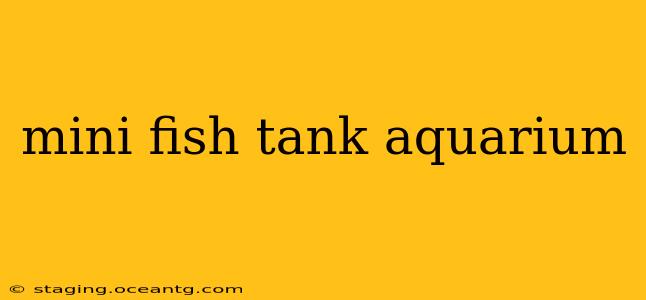Mini fish tank aquariums are gaining immense popularity, offering a captivating glimpse into aquatic life without the commitment of a larger setup. Whether you're a seasoned aquarist or a curious beginner, this comprehensive guide will explore everything you need to know about these charming miniature ecosystems. From choosing the right tank and inhabitants to maintaining a healthy environment, we'll cover it all.
What are the different types of mini fish tanks?
Mini fish tanks come in various shapes, sizes, and styles. You'll find everything from simple, rectangular glass tanks to more elaborate, designer bowls and cube aquariums. Some are designed for desktop use, while others are more versatile. Consider your available space, desired aesthetic, and budget when choosing a mini aquarium. Popular choices include:
- Desktop Aquariums: Small, compact tanks designed to fit easily on desks or shelves.
- Bowfront Aquariums: Offer a wider viewing area than standard rectangular tanks.
- Cube Aquariums: Stylish and modern, providing a unique perspective of aquatic life.
- Nano Aquariums: Typically range from 2 to 10 gallons, offering a balance between size and practicality.
What is the best size mini fish tank for beginners?
For beginners, a 2 to 5-gallon nano aquarium is an excellent starting point. These smaller tanks are easier to manage and maintain, allowing you to gain experience before scaling up. Larger tanks require more extensive filtration and water change routines. Starting small reduces the risk of overwhelming yourself with the responsibilities of fishkeeping.
What fish are suitable for a mini fish tank?
Choosing the right fish is crucial for a healthy and thriving mini aquarium. Avoid overcrowding, which can quickly lead to poor water quality and stress for your fish. Smaller, peaceful species are ideal for nano tanks. Some good choices include:
- Betta Fish (Siamese Fighting Fish): While they can be kept alone, it's crucial to avoid housing males together due to their aggressive nature. A single betta is often ideal for a 5-gallon tank.
- Dwarf Corydoras: Small, peaceful bottom-dwelling catfish.
- Neon Tetras: A shoaling species, requiring at least six individuals to thrive.
- Guppies: Relatively hardy and peaceful fish, but ensure your tank is appropriately sized for their numbers.
It is extremely important to research the specific needs of any fish species before introducing them to your aquarium. Consider factors like water parameters, adult size, and social behavior. Overstocking, even in a small tank, can rapidly lead to poor water quality and the demise of your fish.
What equipment do I need for a mini fish tank?
While mini aquariums are compact, they still require essential equipment to maintain a healthy environment:
- Filter: A reliable filter is crucial for removing waste products and keeping the water clean. Choose a filter appropriate for the tank's size.
- Heater (optional): Depending on the chosen fish species, a heater may be necessary to maintain the ideal water temperature.
- Substrate: This forms the bottom layer of your aquarium. Sand or small gravel are popular choices.
- Decorations: Add aesthetically pleasing rocks, plants, and other decorations to create a visually appealing environment for your fish.
How do I clean a mini fish tank?
Regular maintenance is key to a healthy mini aquarium. This includes:
- Partial Water Changes: Weekly partial water changes (25-50%) are recommended to remove accumulated waste and maintain water quality.
- Filter Maintenance: Clean or replace your filter media according to the manufacturer's instructions.
- Substrate Cleaning: Gently siphon any debris from the substrate during water changes.
- Algae Removal: Regularly remove algae growth using an algae scraper or algae pad.
How often should I change the water in a mini fish tank?
The frequency of water changes depends on several factors, including tank size, stocking levels, and filtration efficiency. However, weekly partial water changes (25-50%) are generally recommended for mini aquariums. Larger water changes may be needed if water quality deteriorates. Regular testing of water parameters will help you determine the appropriate frequency.
How much does a mini fish tank cost?
The cost of a mini fish tank can vary greatly depending on the size, features, and included equipment. You can find basic setups for under $50, while more elaborate, fully equipped tanks can cost significantly more. Factor in the cost of fish, substrate, decorations, and any necessary water testing equipment when budgeting for your mini aquarium.
By following these guidelines, you can create and maintain a thriving miniature underwater world that brings joy and relaxation to your home or office. Remember, research is key! Thoroughly understand the needs of any fish you plan to keep before bringing them home. Happy fishkeeping!
